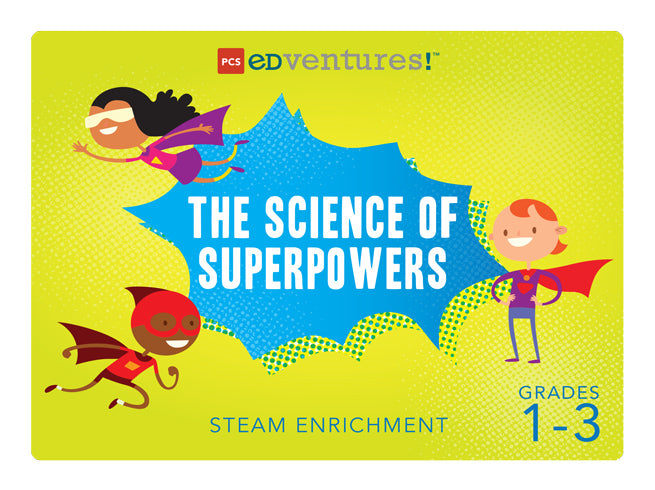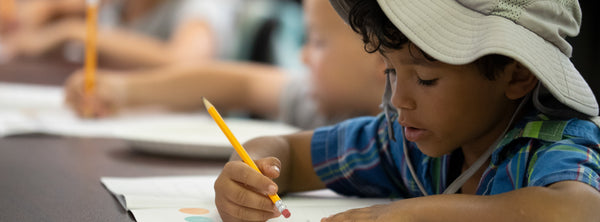
The Superpowers of STEM in Out-of-School Programs
In 2020, as the coronavirus pandemic closed down schools all around the world, educators did their best to implement virtual lessons to meet their students’ academic, social and emotional needs. Unfortunately, many students struggled with remote learning and navigating unfamiliar online platforms, especially students from lower-income families who lacked the technology, educational resources and other opportunities that come with financial security.
Many students experienced significant learning loss during this crisis, much steeper than the typical summer slide. This post-pandemic decline in student learning has been termed the COVID-19 slide. Math achievement, in particular, received the biggest sucker punch. Students in grades 3-8 dropped an average of 5-10 percentile points lower in math from 2019 to 2020, but luckily maintained similar reading scores (Hawkins, 2020).
How can we help students overcome the slide and bridge this achievement gap? We can harness the Superpowers of STEM!
STEM is an interdisciplinary approach to teaching Science, Technology, Engineering and Math that encourages learners to apply their knowledge and skills to solve meaningful, real-world problems. STEM education is definitely important in the classroom, but does it play an equally essential role in out-of-school programs? The answer is YES!
Here’s how out-of-school programs can harness the superpowers of STEM to help learners reach their greatest potential.
STEM Superpower #1: Accelerates Learning

When out-of-school programs provide students with additional STEM enrichment activities outside of the classroom, it supports and strengthens the academic learning done during the school day
By engaging in hands-on, content-rich explorations, learners are able to dive deeper into the concepts and gain a better understanding of the world around them. This is because STEM encourages the development of important scientific inquiry skills, such as asking questions and making predictions, hypothesizing and experimenting, making observations and recording data, iterating and improving, analyzing patterns and communicating results. Students who participate in STEM activities during out-of-school programs have additional time to practice their scientific inquiry skills and accelerate their learning.
STEM Superpower #2: Bridges the Achievement Gap
Participation in additional STEM enrichment activities outside of the regular school day is essential to bridge the achievement gap due to the COVID-19 slide.
The extra time to develop STEM skills is especially important for diverse student populations who are traditionally underrepresented in STEM majors and careers. This includes students of color, low income youth, English language learners and girls (Morgan, Farkas, Hillemeier, & Maczuga, 2016). For example, the current STEM workforce consists primarily of White and Asian workers, while Hispanics only account for 8% and African Americans account for 9%. Although women make up approximately 50% of the STEM workforce, they are underrepresented in certain STEM occupations, such as computing (25%) and engineering (15%) (Fry, Kennedy, & Funk, 2021). In order to level the playing field and bridge this achievement gap, it is critical for out-of-school programs to provide engaging, high-quality STEM opportunities.
STEM Superpower #3: Builds Positive STEM Attitudes
As our world has become increasingly more technology-based, the demand for STEM-focused careers has skyrocketed. The United States, however, has been struggling to find people who possess the necessary STEM skill sets to fill these positions. One possible reason for this lack of qualified applicants is the decline of children’s performance and attitudes towards STEM (OECD, 2015). Several longitudinal studies have discovered that childhood STEM attitudes are a strong indicator of future STEM achievement during adolescence (Morgan, et al., 2016), college and beyond (Tai, Liu, Maltese, & Fan, 2006).
Luckily, early participation in STEM activities has been found to create positive STEM attitudes which help learners later in life. One study found that 65-85% of students in out-of-school programs who participated in STEM activities for more than 4 weeks showed an increase in STEM engagement, knowledge, identity and career interest (Allen, P.J., Chang, R., Gorrall, B.K. et al, 2019). Additionally, many out-of-school programs build positive STEM attitudes by providing opportunities for learners to meet STEM professionals, investigate STEM majors and careers and envision themselves working in STEM fields (Young, Ortiz, & Young, 2017).
STEM Superpower #4: Boosts Social and Emotional Learning (SEL)

Out-of-School STEM programs that focus on social and emotional skills, in addition to academics, are the most beneficial for student learning. When out-of-school programs focus solely on academics, they have been found to be much less effective.
Students thrive in a safe and supportive learning environment where they can participate in hands-on STEM activities, have the freedom to explore different topics that interest them and have multiple opportunities to build relationships with other peers and adults. STEM activities boost social and emotional learning as learners develop self-awareness, self-management, social-awareness, relationship skills and responsible decision-making. In turn, their bolstered social and emotional skills positively impact their future STEM attitudes and success in life (Young, et al., 2017).
STEM Superpower #5: Strengthens 21st Century Skills
As learners participate in meaningful, real-world STEM challenges, they practice and strengthen their 21st century skills of creativity, critical thinking, problem solving, perseverance, teamwork, communication and collaboration.
In fact, students in afterschool programs who participated in STEM activities for at least one hour per week for more than 4 weeks significantly increased their social and emotional learning and 21st century skills. (Allen, et al., 2019). This is important because employers are now looking for candidates who possess both SEL and 21st century skills, in addition to content knowledge and experience, when hiring for STEM-focused positions (Afterschool Alliance, 2017).
The COVID-19 slide is a call to action
for all educators.
Out-of-school programs, in particular, have a unique opportunity to provide additional STEM activities to enhance student learning in the classroom. By harnessing the superpowers of STEM in a safe and supportive environment, they have the power to help students accelerate their learning, bridge the achievement gap, build positive STEM attitudes, foster social and emotional learning and strengthen 21st century skills. Just like Batman and Robin, traditional schooling and out-of-school programs need to team up and work together to use their STEM superpowers to help learners reach their greatest potential.
Are you ready to join forces with PCS Edventures and activate the superpowers of STEM in your out‑of‑school program?
Soar Like Superman with STEM Freebie Activity
Try this freebie activity to see how easy it is to implement hands-on STEM activities in your out-of-school programs. Sit back, grab some popcorn and watch the superpowers of STEM in action. It’s a bird, it’s a plane—no, it’s your students soaring to new heights!
Want More STEM Superhero Activities?
The Science of Superpowers Enrichment Program (Grades 1-3)
Summer was filled with watching movies and reading comic books about heroes and villains, challenges and triumphs. Now the stage is set to explore The Science of Superpowers. Excite students about STEM as they design solutions to help their favorite superhero characters. Through 12 days of hands-on activities in biology, engineering and technology, students fly alongside Wonder Woman's invisible jet, sling webs with Spider-Man and use laser vision to identify the real-life heroes of our world.

Author: Laura Kitagawa
Laura has over 20 years of experience in education as an elementary teacher, science specialist, and STEM curriculum developer. She is driven to engage, inspire and empower students with meaningful, hands-on STEM activities.











